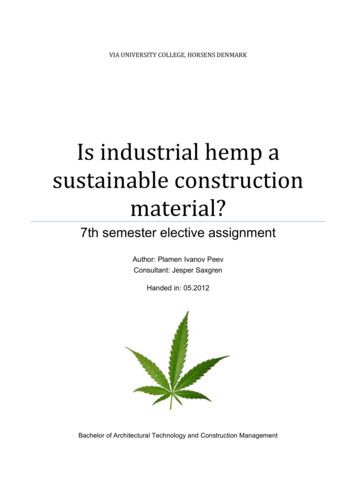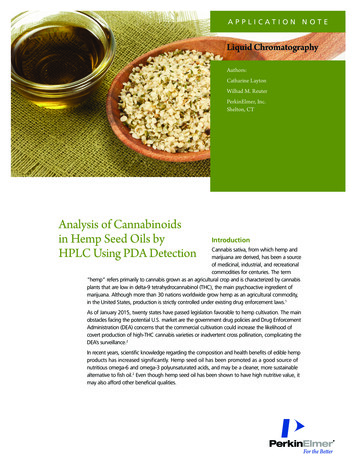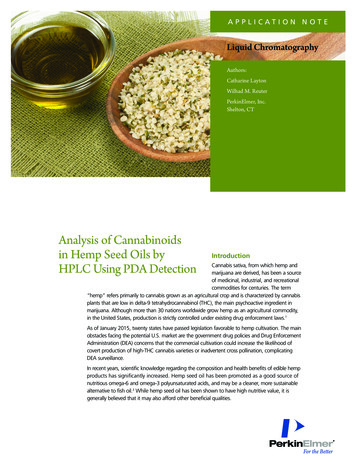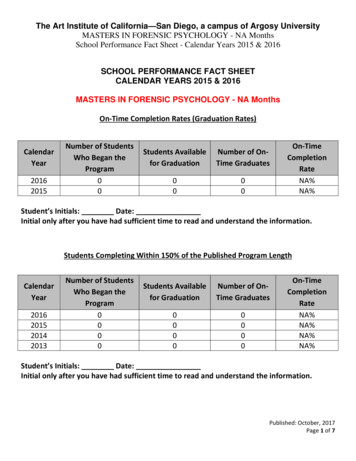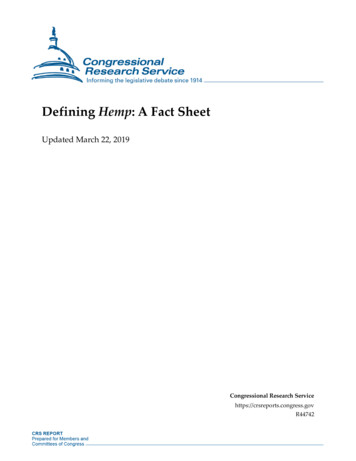
Transcription
Defining Hemp: A Fact SheetUpdated March 22, 2019Congressional Research Servicehttps://crsreports.congress.govR44742
Defining Hemp: A Fact Sheetotanically, hemp and marijuana are from the same species of plant, Cannabis sativa,1 butfrom different varieties or cultivars.2 However, hemp and marijuana are geneticallydistinct forms of cannabis that are distinguished by their use and chemical composition aswell as by differing cultivation practices in their production. While marijuana generally refers tothe cultivated plant used as a psychotropic drug (whether used for medicinal or recreationalpurposes), hemp is cultivated for use in the production of a wide range of products, includingfoods and beverages, personal care products, nutritional supplements, fabrics and textiles, paper,construction materials, and other manufactured and industrial goods. Hemp and marijuana alsohave separate statutory definitions in U.S. law.BDespite these differences, growing hemp has been restricted in the United States until recently,and the U.S. market has been largely dependent on imports for finished products and as aningredient for use in further processing. Hemp’s association with marijuana placed its productionunder U.S. drug laws wherein all cannabis varieties, including hemp, were considered Schedule Icontrolled substances under the Controlled Substances Act (CSA).3 Since the late 1950s, the U.S.Drug Enforcement Administration (DEA) has strictly controlled and regulated hemp production.Prior to the late 1950s, hemp in the United States was considered an agricultural commodity, andthe U.S. Department of Agriculture (USDA) supported its production.4Restrictions on U.S. hemp production and marketing were relaxed by changes enacted in the 2014farm bill (Agricultural Act of 2014, P.L. 113-79) and were further relaxed in the 2018 farm bill(Agriculture Improvement Act of 2018, P.L. 115-334). These changes provide furtherdifferentiation between hemp and marijuana in terms of farm policy and federal regulatoryoversight.The Food and Drug Administration (FDA) maintains oversight of hemp-derived consumerproducts under the Federal Food, Drug, and Cosmetic Act (21 U.S.C. §§ 301 et seq.). FDA’sjurisdiction includes hemp and hemp-derived products as a food and food ingredient, as well asan ingredient for use in body products, cosmetics, dietary supplements, and therapeutic products.Hemp and marijuana are distinct in several key ways: (1) statutory definitions and regulatoryoversight, (2) chemical and genetic compositions, and (3) production practices and use. This factsheet describes these differences, which are summarized in Figure 1.1In this report, cannabis refers to the plant species Cannabis sativa and all of its industrial, medicinal, and recreationalvarieties. The terms industrial hemp and hemp are used interchangeably, and the term marijuana refers to the plantused as a medicinal or recreational drug unless otherwise specified. The terms Cannabis sativa L denote use of theLinnean system of taxonomy.2 Plant varieties and cultivars both refer to unique characteristic of a particular plant, but they differ overall: Varietiesoften occur in nature, and most varieties are true to type, meaning that seedlings grown from a variety will also havethe same unique characteristic of the parent plant. Cultivars are cultivated varieties and not necessarily true to type,since certain traits have been selected by growers. See Cindy Haynes, “Cultivar versus Variety,” Iowa State University,February 6, 2008, ltivarOrVariety.html.3 21 U.S.C. §§801 et seq.; Title 21 C.F.R. Part 1308.11.4 Strictly speaking, the CSA does not make growing hemp illegal, but makes it illegal to grow without a DEA permit.Congressional Research Service1
Defining Hemp: A Fact SheetFigure 1. Differences Between Hemp and MarijuanaSource: CRS from various governmental and industry sources.Congressional Research Service2
Defining Hemp: A Fact SheetStatutory Definition and Regulatory OversightCongress expanded the definition for hemp in the 2018 farm bill (amending the 2014 farm billdefinition of industrial hemp), further distinguishing hemp and marijuana under U.S. law. Hempis codified in Section 297A of the Agricultural Marketing Act of 1946 (AMA, 7 U.S.C. 1621 etseq.) as:5the plant Cannabis sativa L. and any part of that plant, including the seeds thereof and allderivatives, extracts, cannabinoids, isomers, acids, salts, and salts of isomers, whethergrowing or not, with a delta-9 tetrahydrocannabinol concentration of not more than 0.3percent on a dry weight basis.As defined in statute, hemp must contain no more than a 0.3% concentration of delta-9tetrahydrocannabinol (delta-9 THC)—marijuana’s primary psychoactive chemical. In general, alevel of about 1% THC is considered the threshold for cannabis to have a psychotropic effect oran intoxicating potential.6 Some suggest that cannabis with a THC level of greater than 1% beconsidered a drug varietal (e.g., marijuana),7 with some suggesting that marijuana plants oftenhave a THC level of 5% or more.8 In the United States, hemp varieties or cultivars having lessthan 0.3% THC may be cultivated under USDA-approved license as hemp, while plant varietiesor cultivars having higher amounts of THC may not be cultivated as they are considered to havetoo high a potential for drug use.9By contrast, marijuana (or “marihuana,” as it is spelled in the older statutes) is more broadlydefined in the CSA and does not specify a permissible limit for THC or any other cannabinoid:(16) The term “marihuana” means all parts of the plant Cannabis sativa L., whethergrowing or not; the seeds thereof; the resin extracted from any part of such plant; and everycompound, manufacture, salt, derivative, mixture, or preparation of such plant, its seeds orresin. Such term does not include the mature stalks of such plant, fiber produced from suchstalks, oil or cake made from the seeds of such plant, any other compound, manufacture,salt, derivative, mixture, or preparation of such mature stalks (except the resin extractedtherefrom), fiber, oil, or cake, or the sterilized seed of such plant which is incapable ofgermination.10Marijuana is a Schedule I controlled substance under federal law, and, as such, the unauthorizedmanufacture, distribution, dispensation, and possession of marijuana is prohibited.11 Cannabis5A definition of hemp was originally established in the 2014 farm bill and amended by the 2018 farm bill (P.L. 115334, §10113). The 2014 farm bill defined industrial hemp to mean “the plant Cannabis sativa L. and any part of suchplant, whether growing or not, with a delta-9 tetrahydrocannabinol concentration of not more than 0.3 percent on a dryweight basis” (7 U.S.C. §5940(b)(2)).6 See, for example, E. Small and D. Marcus, “Hemp: A New Crop with New Uses for North America,” in Trends inNew Crops and New Uses, ed. J. Janick and A. Whipkey (Alexandria, VA: American Society for Horticultural SciencePress, 2002).7 F. Grotenhermen and M. Karus, “Industrial Hemp Is Not Marijuana: Comments on the Drug Potential of FiberCannabis,” nova-Institute, iha5210.html.8 See, for example, M. Shipman, “Is Hemp the Same Thing as Marijuana?,” North Carolina State University, February15, 2019, https://phys.org/news/2019-02-hemp-marijuana.html; and D. Donnon, A. T. Kearney, “The New GreenRush,” presented at a Food Institute webinar, January 31, 2019.9 E. Small and D. Marcus, “Tetrahydrocannabinol Levels in Hemp (Cannabis sativa) Germplasm Resources,”Economic Botany, vol. 57, no. 4 (October 2003); and G. Leson, “Evaluating Interference of THC Levels in Hemp FoodProducts with Employee Drug Testing” (prepared for the province of Manitoba, Canada), July 2000.10 21 U.S.C. §802(16).11 Generally, all cannabis varieties are commonly considered to be of a single species. However, not all researchersCongressional Research Service3
Defining Hemp: A Fact Sheetthat exceeds the 0.3% delta-9 THC concentration limit falls under the definition of marijuana andthe CSA. THC levels in marijuana reportedly average about 10%, with a high of 30%concentration.12 However, advancements in cannabis breeding have introduced plant varietieswith even higher levels of THC and other cannabinoids.13The definition of industrial hemp enacted in the 2014 farm bill allowed for hemp cultivationunder certain narrowly prescribed circumstances—namely, for research purposes by researchinstitutions and state departments of agriculture in states with laws allowing for hemp production.Although hemp production was allowed in accordance with the requirements of the 2014 farmbill provision, other aspects of production were still subject to CSA regulations and DEAoversight, including the importation of viable seeds, which still required DEA registrationaccording to the Controlled Substances Import and Export Act (21 U.S.C. §§951-971). This andother requirements were reinforced in a 2016 joint Statement of Principles on Industrial Hempissued by DEA, USDA, and FDA.14 The 2016 guidance also clarified DEA’s contention that thecommercial sale or interstate transfer of hemp continued to be restricted. A May 2018 internaldirective by the DEA later clarified that certain “products and materials that are made from thecannabis plant and which fall outside the CSA definition of marijuana (such as sterilized seeds,oil or cake made from the seeds, and mature stalks) are not controlled under the CSA.”15Accordingly, such products may be sold and distributed throughout the United States withoutrestriction under the CSA or its implementing regulations. The 2018 directive, however, does notapply to cannabis extracts and resins.16The 2018 farm bill further expanded upon hemp policies in the 2014 farm bill by amending theCSA and removing hemp from the CSA definition of marijuana (21 U.S.C. §802(16)).17Removing hemp (as defined in AMA Section 297A) from the CSA—and thus removing it frombeing considered a controlled substance—effectively permits the cultivation, processing,marketing, and sale of hemp and any cannabinoid derived from hemp that is produced by anauthorized grower in accordance with the 2018 farm bill, associated federal USDA regulations,and applicable state regulations. The 2018 farm bill also excludes THCs in hemp (as defined)from Schedule I of the CSA.18 All other cannabis and cannabis-derived products remain aSchedule I substance under federal law and are thus subject to CSA regulations and DEAoversight, except for certain drug products approved by FDA. Regardless of whether a substanceis hemp-derived, it is FDA’s view that it is unlawful to market food or dietary supplementsagree on a single taxonomy. Other cannabis species may include Cannabis indica (meaning from India) and its knownsubspecies. See, for example, R. C. Clarke and M. D. Merlin, “Cannabis Taxonomy: The ‘Sativa’ versus ‘Indica’Debate,” HerbalGram, vol. 13, no. 4 (April 2016).12 Based on sample tests of illegal cannabis seizures from December 2007 through March 2008. National Institute ofDrug Abuse, “Quarterly Report, Potency Monitoring Project,” University of Mississippi, 2008.13 See, for example, M. A. ElSohly et al., “Changes in Cannabis Potency over the Last Two Decades (1995-2014):Analysis of Current Data in the United States,” Biological Psychiatry, vol. 79, no. 7 (April 1, 2016): pp. 613-619.14 81 Federal Register 156: 53395-53396, August 12, 2016; also DEA/USDA/FDA joint “Statement of Principles onIndustrial Hemp,” August 2016.15 DEA, “DEA Internal Directive Regarding the Presence of Cannabinoids in Products and Materials Made from theCannabis Plant,” May 22, 2018.16 81 Federal Register 240: 90194-90196, December 14, 2016. See also DEA, “Clarification of the New Drug Code(7350) for Marijuana Extract,” uana/m extract 7350.html.17 P.L. 115-334, §12619(a).18 P.L. 115-334, §12619(b).Congressional Research Service4
Defining Hemp: A Fact Sheetcontaining cannabidiol (CBD) or other cannabinoids, as well as any products making therapeuticclaims without FDA approval.19The 2018 farm bill also established a new regulatory framework to monitor compliance andregulate production under USDA’s jurisdiction.20 The 2018 farm bill also contains an “interstatecommerce” provision that prohibits states and Indian tribes from interfering with the transport ofhemp or hemp products produced in accordance with the new USDA requirements through theirjurisdictions.21 Hemp is now also eligible for federal crop insurance programs, as well as USDAresearch and development programs.22 These changes returned U.S. hemp production to the statusof an agricultural commodity and thus eligible for USDA-supported farm programs, similar to thestatus it had in the United States before the late 1950s.Chemical and Genetic MakeupThere are many different varieties of cannabis. Although industrial hemp and marijuana are bothvarieties of cannabis, they have been bred for different uses and can be distinguished by theirchemical and genetic compositions.23Differences in Chemical CompositionThe term industrial hemp dates back to the 1960s and generally refers to cannabis varieties thatare grown primarily as an agricultural crop, such as seeds and fiber and byproducts such as oil,seed cake, and hurds.24 Hemp is generally characterized by plants that are low in delta-9 THC, thedominant psychotrophic compound in Cannabis sativa.25 In addition to its low THC content,hemp generally has high levels of CBD, the primary nonpsychotropic compound in Cannabissativa.26 Accordingly, a high ratio of CBD to THC might also be a metric used to differentiatehemp from other cannabis varieties.27FDA, “Statement from FDA Commissioner Scott Gottlieb, M.D., on the Signing of the Agriculture Improvement Actand the Agency’s Regulation of Products Containing Cannabis and Cannabis-Derived Compounds,” press release,December 20, 2018.20 P.L. 115-334, §10114.21 P.L. 115-334, §10113.22 For more information, see CRS In Focus IF11088, 2018 Farm Bill Primer: Hemp Cultivation and Processing.23 See, for example, S. L. Datwyler and G. D. Weiblen, “Genetic Variation in Hemp and Marijuana (Cannabis sativaL.) According to Amplified Fragment Length Polymorphisms,” Journal of Forensic Sciences, vol. 51, no. 2 (2006).24 See L. Grlic, “A Combined Spectrophotometric Differentiation of Samples of Cannabis,” United Nations Office onDrugs and Crime, January 1968. Hurds are soft inner core fiber of the hemp stalk. Hurds are woody in texture andmostly used in non-woven items, including hempcrete and animal bedding.25 R. C. Clarke and M. D. Merlin, Cannabis: Evolution and Ethnobotany (University of California Press, 2013), p. 255.A psychotrophic drug is capable of affecting mental activity, behavior, or perception and may be mood-altering.26 U. R. Avico et al., “Variations of Tetrahydrocannabinol Content in Cannabis Plants to Distinguish the Fibre-Typefrom Drug-Type Plants,” UNODC Bulletin on Narcotics, January 1985; C. W. Waller, “Chemistry of Marihuana,”Pharmacological Reviews, vol. 23 (December 1971); K. W. Hillig and P. G. Mahlberg, “A Chemotaxonomic Analysisof Cannabinoid Variation in Cannabis (Cannabaceae),” American Journal of Botany, vol. 91, no. 6 (June 2004); and A.W. Zuardi et al., “Cannabidiol, a Cannabis sativa Constituent, as an Antipsychotic Drug,” Brazilian Journal of Medicaland Biological Research, vol. 39 (2006).27 Continued advancement in breeding and plant genetics, however, are resulting in cannabis varieties or cultivars thathave more equal parts THC and CBD, making previous generalizations about the inverse relationship between THCand CBD concentration less relevant.19Congressional Research Service5
Defining Hemp: A Fact SheetTHC and CBD are among the subclasses of cannabinoids and their 66 known variants inCannabis sativa (see text box).28 Cannabinoids refer to the unique chemical compoundsproduced in the plant, which are known to exhibit a range of psychological and physiologicaleffects.29 These compounds exist in both hemp and marijuana in varying amounts. THC is theprimary psychoactive compound in cannabis; however, the plant contains multiple THC isomersand variants.30 While some cannabinoids are psychoactive, others, such as CBD, are notconsidered to be psychoactive.31 THC and CBD are considered to be among the most abundantcannabinoids in cannabis, and some consider both to be medically valuable. THC and CBD arealso the most well-known and researched cannabinoids. Among the isomers of THC, propertiesmay vary and not all have been well-characterized.32 The interaction between THC and othercannabinoids in the cannabis plant is also not well known.CannabinoidsMore than 480 natural components are found within the Cannabis sativa plant, of which 66 are classified as cannabinoids.Cannabinoids are separated into the following subclasses.Delta-9 tetrahydrocannabinol (delta-9 THC)Number of known variants: 9Delta-8 tetrahydrocannabinol (delta-8 THC)Number of known variants: 2Cannabigerol (CBG)Number of known variants: 6Cannabichromene (CBC)Number of known variants: 5Cannabidiol (CBD)Number of known variants: 7Cannabinol (CBN)Number of known variants: 7Cannabinodiol (CBND or CBDL)Number of known variants: 2Cannabicyclol (CBL)Number of known variants: 3Cannabielsoin (CBE)Number of known variants: 5Cannabitriol (CBT)Number of known variants: 9Other miscellaneous types of cannabinoidsNumber of known variants: 11Source: J. E. Joy et al., eds., Marijuana and Medicine: Assessing the Science Base, Institute of Medicine, 1999; andUniversity of Washington, Alcohol and Drug Abuse Institute, “Cannabinoids,” June 2013.More than 540 phytochemicals have been described in hemp (see J. Gould, “The Cannabis Crop,” Nature, vol. 525,no. S2–S3 [September 24, 2015]). Other present compounds include certain terpenes and phenolic compounds,including flavonoids. See footnote 49.29 Clarke and Merlin, Cannabis: Evolution and Ethnobotany, p. 255.30 Isomers are molecules with the same chemical formula but distinct atomic structures.31 Clarke and Merlin, Cannabis: Evolution and Ethnobotany. For example, cannabigerol, cannabichromene, andcannabidivarin are reported to be nonpsychotrophic.32 See, for example, E. A. Carlini, “The Good and the Bad Effects of (-) Trans-Delta-9-Tetrahydrocannabinol (Δ9THC) on Humans,” Toxicon, vol. 44 (July 2004), pp. 461-467. Other identified isomers of THC, such as delta-1 THCand delta-6 THC, may be related to delta-9 THC and delta-8 THC, respectively.28Congressional Research Service6
Defining Hemp: A Fact SheetDifferences in Genetic CompositionScientific and genome research indicate that hemp and marijuana are neither genetically identicalnor genetically similar. Although hemp and marijuana are from the same cannabis plant, availableresearch supports the conclusion that selective breeding has resulted in two separate strains.A 2015 study by Canadian researchers reports that “marijuana and hemp are significantlydifferentiated at a genome-wide level, demonstrating that the distinction between thesepopulations is not limited to genes underlying THC production.”33A 2015 University of Minnesota study notes that marijuana and hemp “can be readilydistinguished by the relative yield” of tetrahydrocannabinolic acid (THCA) in marijuana andcannabidiolic acid (CBDA) in hemp.34 The study observed a “diversity of THCA and CBDAsynthase sequences observed in the mapping population, the position of enzyme coding loci onthe map, and patterns of expression suggest multiple linked loci.” The study also found thatmarijuana is distinguished from hemp by compounds that appear to have been “positivelyselected to enhance psychoactivity.”35The discovery of a single gene distinguishing two plant varieties suggests that the two plants aredistinct. A 2011 Canadian study further concluded that “single nucleotide variant analysisuncovered a relatively high level of variation among four cannabis types, and supported aseparation of marijuana and hemp.”36 These studies find that available research and genomemapping suggest that hemp and marijuana are genetically separate and distinct plant varieties.Genomic research in Canada supports the notion that over thousands of years of cultivation,cannabis farmers have “selectively bred Cannabis sativa into two distinct strains—one for fiberand seed, and one for medicine.”37Production Practices and UseIn general, hemp is grown and harvested differently from marijuana. Production practices amongcannabis varieties vary with respect to cultivation, including plant height, density, and timing oftheir harvest. While marijuana is cultivated to promote the development of flowering tops andleaves of psychoactive cannabis plant varieties with elevated concentrations of THC, hemp iscultivated depending on its intended use across three different crops: fiber, seeds, and flower(Table 1).J. Sawler et al., “The Genetic Structure of Marijuana and Hemp,” August 2015, PLoS ONE, vol. 10, no. 8,https://journals.plos.org/plosone/article?id 10.1371/journal.pone.0133292.34 G. D. Weiblen et al., “Gene Duplication and Divergence Affecting Drug Content in Cannabis Sativa,” NewPhytologist, July 17, 2015, https://doi.org/10.1111/nph.13562.35 Weiblen et al., “Gene Duplication and Divergence.”36 H. van Bakel et al., “The Draft Genome and Transcriptome of Cannabis Sativa,’” Genome Biology, vol. 12, no. 10(October 20, 2011), https://doi.org/10.1186/gb-2011-12-10-r102.37 ScienceDaily, “How Hemp Got High: Cannabis Genome Mapped,” October 24, 2011, citing vanBakel et al., “TheDraft Genome and Transcriptome of Cannabis Sativa.”33Congressional Research Service7
Defining Hemp: A Fact SheetTable 1. Primary Hemp Crops: Fiber, Seeds, and FlowersFiberSeed/GrainsFlowerDesired PlantMaterialStalks (bast fibers and hurd/corefibers)Dried (high in oil and protein)Dried and cut (flower bud and floralmaterial)Planting DensityDense spacing to discouragebranching and flowering (35-50plants/ft2)Dense spacing to discouragebranching and flowering (3550 plants/ft2)Well-spaced (typically planted 3-4feet apart on a 3-5 foot center)PhysicalCharacteristicsTall plants with small stalks andless leafy materialPlants with small stalks andless leafy materialBushy plant with wide branching topromote flowers/buds (selectingfemale plants is ideal)Harvest Height10-15 feet6-9 feet4-8 feetHarvestingConsiderationsTypically using hay equipment(mow, field retting 2-3 weeks,then roll balling)Must be harvested within ashort window due to seedscatter issuesHarvesting is highly labor intensive, inpart given possible degradation ofplant material related to efforts topreserve the chemical properties ofthe plant’s flowering heads; alsorequires drying down to 10%moistureYields1.0-5.5 tons per acre of drymatter (whole dry stems)Avg: 800-1,000 lbs./acre (upto 1,600 lbs./acres)NA (varies widely); one plant yieldsabout one pound of dried materialPrice (2017) 70- 135 per ton 0.65- 0.75 per pound 25- 200 per poundForwardContractingAbout 8 /lb. ( 160/ton).NANAReturn per AcreUp to 700 per acreUp to 1,200 per acreNACommon UsesBast fibers used for paper,insulation, composites, andtextiles; core fibers used foranimal bedding, concrete,fiberboard, and oil absorbentsFoods and body productsShelled seed and finesOil and seed cakeExtractions of plant resin (CBD,other cannabinoids)Nutraceuticals and wellness productsPost-ProductionProcessDecortication, removing thetough woody interior (hurd)from the softer, fibrous exteriorof the stalk (separating the bastand the hurd/core fibers)Dehulling and pressing ofdried hemp seed/grainsRequires extraction using a variety ofmethods, including lipid oralcohol/ethanol infusions, CO2extraction, or extraction using othertypes of chemical solvents (hexane,butane), as well as solvent-freeextractions; extraction may or maynot involve heat decarboxylationSource: CRS from various sources, including K. Pularski, “Hemp Industry Overview,” presentation at hempconference hosted by the Greater Peoria Economic Development Council, Illinois, January 18, 2019.Notes: Most figures are based on 2017 Kentucky crop data. Production data for other producing regions mayvary. NA Not available.Cannabis is dioecious, meaning that there are separate male and female plants, each withdistinctive growth characteristics. For drug production, the female flowers are more valuable,whereas male plants are used to produce hemp fibers. When cannabis is grown to producemarijuana, it is cultivated from varieties where the female flowers are specifically selected toprevent the return of separate male and female plants.38 When cultivating marijuana, the femaleflowers are short and tightly clustered. In marijuana cultivation, growers remove all the maleVan Bakel et al., “The Draft Genome and Transcriptome of Cannabis Sativa.” In botany, dioecious describes plantvarieties that possess male and female flowers or other reproductive organs on separate, individual plants.38Congressional Research Service8
Defining Hemp: A Fact Sheetplants to prevent pollination and seed set. Some growers will hand-pollinate a female plant to getseed. This is done in isolation from the rest of the female plants. Encouraging monoecism(female-only plants) in marijuana cultivation requires the skill of a competent plant breeder andrarely occurs under non-cultivated conditions. By contrast, when cannabis is grown to producehemp fiber and seeds (using only male plants), the plant is discouraged from flowering, forcing itto grow taller with less branching.Cannabis seeds generally fall into one of three categories: regular, feminized, or autoflowering.39Regular seeds produce both male and female plants at about a 50/50 ratio, but often male plantsmay be identified to avoid the fertilization of the female plants. Feminized seeds are speciallytreated plants to produce only female plants, generally by stressing a female plant to produceviable, genetically identically seeds without being fertilized by a male plant, resulting in femaleoffspring only. Autoflowering seeds are cross‐bred hybrids that generally result in all femaleplants that often contain less THC.40 Some seeds are being genetically and/or selectively bred toproduce strains that have zero THC.41Preserving the genetic composition of each variety requires careful attention to the prevention ofcross-pollination. Cross-pollination among the different varieties is a concern because cannabisplants are open (e.g., wind and/or insect pollinated), and thus cross-pollination is possible if thecrops are grown in close proximity. Cross-pollination would result in unwanted characteristics inboth industrial hemp and marijuana. For growers of marijuana, cross-pollination with hemp couldsignificantly lower the THC content and thus degrade the value of the marijuana crop. Likewise,growers of hemp would seek to avoid cross-pollination with marijuana plants, especially giventhe illegal status of marijuana. If hemp varieties are grown in or around marijuana, the hempwould pollinate the female marijuana plant. Likewise, marijuana growers would not want to plantnear hemp fields, because this could result in harvests that are seedy and lower in THC and thusdegrade the value of their marijuana crops. Plants grown for oilseed are also marketed accordingto the purity of the oilseed, and the mixing of other genotypes would degrade the value of thecrop.42Differences in the cultivation practices between marijuana and hemp generally result in differentobservable traits under field conditions.43 Visual plant differences between hemp and marijuanagenerally include plant height (hemp is often encouraged to grow tall, whereas marijuana isselected to grow short and tightly clustered); cultivation (hemp is often grown as a single mainstalk with few leaves and branches, whereas marijuana is encouraged to become bushy with manyleaves and branches to promote flowers and buds); and planting density (hemp is often denselyplanted to discourage branching and flowering, whereas marijuana plants are well-spaced).I. Zeiler and C. Bussink, “The Cannabis Seeds Business,” draft report by researchers at the United Nations Office onDrugs and Crime, 2012.40 Zeiler and Bussink, “The Cannabis Seeds Business.”41 See, for example, BusinessWire, “GenCanna Announces First Patentable Non-GMO Hemp Genetics with 0.0%THC,” January 28, 2019.42 An example of another plant whereby different crops are cultivated by selecting for different traits is sweet corn andfield corn (or corn for grain). Corn may also naturally cross-pollinate and requires early selection and removal of plantsbefore pollination based on certain plant traits. Intermixing plants of the two types of corn may result in crosspollination and degradation of each crop.43 G. D. Weiblen, University of Minnesota, presentation at the 2013 Annual HIA Conference, Washington, DC,November 17, 2013.39Congressional Research Service9
Defining Hemp: A Fact SheetIn general, the period of seeding to harvest ranges from 70 to 140 days depending on its intendedpurpose, the cultivar or variety planted, and climatic conditions. Different cannabis varieties orcultivars may be harvested at different times depending on the growing area.Recent advances in cannabis research and development, as well as plant breeding and the creationof new cultivars and hybrids, are resulting in plants that do not always precisely present thesedistinctive observable characteristics.44 Specifically, some hemp plants are being grown to beshort and bushy, encouraging larger flowers, often from high-CBD, low-THC hemp seed. Hempplants grown for flower are planted less densely—about three to five feet apart—to encourage theplant to become bushy with many leaves with wide branching to promote flowers and buds.Similarly, marijuana’s high THC content is concentrated pri
Defining Hemp: A Fact Sheet Congressional Research Service 1 otanically, hemp and marijuana are from the same species of plant, Cannabis sativa,1 but from different varieties or cultivars.2 However, hemp and marijuana are genetically distinct forms of cannabis that are distinguished by their use and chemical composition as
